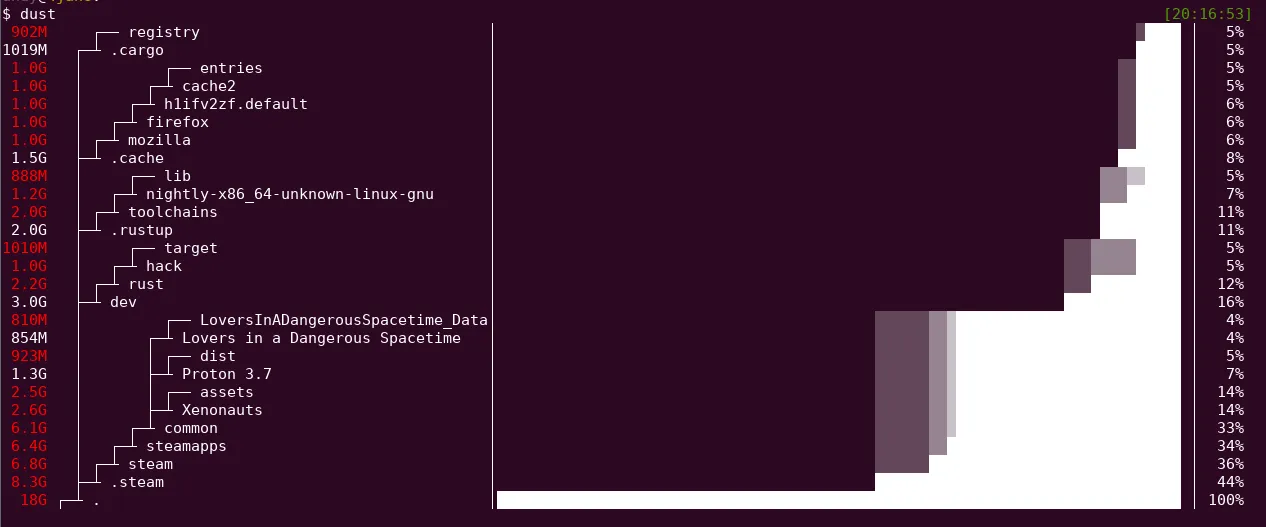Dust - du + rust = dust. Like du but more intuitive
Dust
du + rust = dust. Like du but more intuitive.
Why
Because I want an easy way to see where my disk is being used.
Demo

Overview
Dust is meant to give you an instant overview of which directories are using disk space without requiring sort or head. Dust will print a maximum of one ‘Did not have permissions message’.
Dust will list a slightly-less-than-the-terminal-height number of the biggest subdirectories or files and will smartly recurse down the tree to find the larger ones. There is no need for a ‘-d’ flag or a ‘-h’ flag. The largest subdirectories will be colored.
The different colors on the bars: These represent the combined tree hierarchy & disk usage. The shades of grey are used to indicate which parent folder a subfolder belongs to. For instance, look at the above screenshot. .steam is a folder taking 44% of the space. From the .steam bar is a light grey line that goes up. All these folders are inside .steam so if you delete .steam all that stuff will be gone too.
Install
Cargo
cargo install du-dust
🍺 Homebrew (Mac OS)
brew install dust
🍺 Homebrew (Linux)
brew install dust
Snap Ubuntu and supported systems
snap install dust
Note: dust installed through snap can only access files stored in the /home directory. See danie-dejager/dust-snap#2 for more information.
Pacstall (Debian/Ubuntu)
pacstall -I dust-bin
Anaconda (conda-forge)
conda install -c conda-forge dust
deb-get (Debian/Ubuntu)
deb-get install du-dust
x-cmd
x env use dust
Windows:
scoop install dust- Windows GNU version - works
- Windows MSVC - requires: VCRUNTIME140.dll
Download
- Download Linux/Mac binary from Releases
- unzip file:
tar -xvf _downloaded_file.tar.gz - move file to executable path:
sudo mv dust /usr/local/bin/
Usage
Usage: dustUsage: dust <dir>Usage: dust <dir> <another_dir> <and_more>Usage: dust -p (full-path - Show fullpath of the subdirectories)Usage: dust -s (apparent-size - shows the length of the file as opposed to the amount of disk space it uses)Usage: dust -n 30 (Shows 30 directories instead of the default [default is terminal height])Usage: dust -d 3 (Shows 3 levels of subdirectories)Usage: dust -D (Show only directories (eg dust -D))Usage: dust -F (Show only files - finds your largest files)Usage: dust -r (reverse order of output)Usage: dust -o si/b/kb/kib/mb/mib/gb/gib (si - prints sizes in powers of 1000. Others print size in that format).Usage: dust -X ignore (ignore all files and directories with the name 'ignore')Usage: dust -x (Only show directories on the same filesystem)Usage: dust -b (Do not show percentages or draw ASCII bars)Usage: dust -B (--bars-on-right - Percent bars moved to right side of screen)Usage: dust -i (Do not show hidden files)Usage: dust -c (No colors [monochrome])Usage: dust -C (Force colors)Usage: dust -f (Count files instead of diskspace)Usage: dust -t (Group by filetype)Usage: dust -z 10M (min-size, Only include files larger than 10M)Usage: dust -e regex (Only include files matching this regex (eg dust -e "\.png$" would match png files))Usage: dust -v regex (Exclude files matching this regex (eg dust -v "\.png$" would ignore png files))Usage: dust -L (dereference-links - Treat sym links as directories and go into them)Usage: dust -P (Disable the progress indicator)Usage: dust -R (For screen readers. Removes bars/symbols. Adds new column: depth level. (May want to use -p for full path too))Usage: dust -S (Custom Stack size - Use if you see: 'fatal runtime error: stack overflow' (default allocation: low memory=1048576, high memory=1073741824)"),Usage: dust --skip-total (No total row will be displayed)Usage: dust -z 40000/30MB/20kib (Exclude output files/directories below size 40000 bytes / 30MB / 20KiB)Usage: dust -j (Prints JSON representation of directories, try: dust -j | jq)Usage: dust --files0-from=FILE (Reads null-terminated file paths from FILE); If FILE is - then read from stdinUsage: dust --collapse=node-modules will keep the node-modules folder collapsed in display instead of recursively opening itConfig file
Dust has a config file where the above options can be set. Either: ~/.config/dust/config.toml or ~/.dust.toml
$ cat ~/.config/dust/config.tomlreverse=true← Back to projects